
Swedish postcard by Förlag Nordisk Konst, Stockholm, no. 1117/6. Photo: Svensk Filmindustri. Victor Sjöström and Tore Svennberg in Körkarlen/The Phantom Carriage, (Victor Sjöström, 1920).
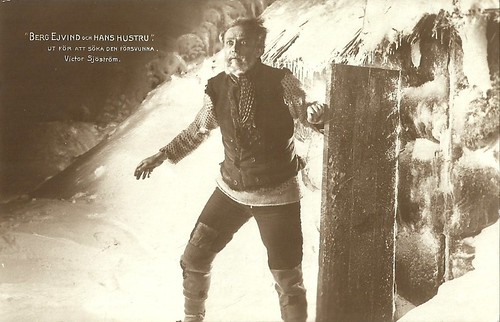
Swedish postcard by Nordisk Konst, Stockholm, no. 844/ 11. Photo: Svenska Biografteatern AB. Victor Sjöström in Berg-Ejvind och hans hustru/The Outlaw and His Wife (Victor Sjöström, 1918). Caption: Out to seek the lost.

Swedish postcard by Svenska Biografteatern, no. 12. Photo: Ferd. Flodin, Stockholm. Victor Sjöström.
The first classic of Swedish cinema
Victor David Sjöström was born in Silbodal, Sweden, in 1879. He was only a year old when his father, Olof Adolf Sjöström, moved the family to Brooklyn, New York, where the father soon built up a successful shipping agency. As a boy, Sjöström was close to his mother, actress Sofia Elisabeth Hartman, who died in New York during childbirth in 1886. The seven-year-old Victor returned to Sweden where he lived with relatives in Stockholm. His uncle was a leading actor at the Royal Dramatic Theatre in Stockholm during the latter part of the 19th century, Victor Hartman.
As a teenager, Sjöström loved the theatre. He formed a theatre society at his Uppsala school, which produced the play 'The Two Deaf Men', in which Sjöström is said to have shown a flair for comedy. In 1895, Olof Sjöström returned from the United States, poor. Victor interrupted his studies and moved in with him in Stockholm. He now began working to support himself and his father, including working in a boarding house in Stockholm and selling novelty doughnuts on the city streets. In 1896, his father died, and Sjöström decided to embark on an acting career in earnest. Sjöström could not afford to attend the Drama School, but instead joined Ernst Ahlbom's theatre company, with which he toured Finland from 1896-1898. In the following decade, he worked for several stage companies in Scandinavia, first as an actor and later also as a director. In 1912-1913, he and Einar Fröberg had a theatre company together - the Fröberg-Sjöströmska Society - which performed in Copenhagen and elsewhere.
Then Charles Magnusson of Svenska Bio hired him and fellow stage director, Mauritz Stiller, to helm motion pictures. Here, Sjöström met the photographer brothers Henrik and Julius Jaenzon, who were to work with him. Sjöström made his acting debut in the Stiller film Vampyren/The Vampire to learn the ropes of filmmaking. The film was shot in 1912 but did not premiere until 1913. His debut as a director was the silent film Ett hemligt giftermål/A Ruined Life (Victor Sjöström, 1912) with Hilda Borgström and John Ekman.
Between 1912 and 1915, Victor Sjöström directed 31 silent films of which only three still survive. His drama Trädgårdsmästaren/The Gardener (Victor Sjöström, 1912) was the first film to ever be banned by the Swedish censor system. Sjöström himself played a brutal gardener who rapes a young, innocent woman (Lili Beck, who became Sjöström's second wife) in his employ in a lovely greenhouse. In the final scene, the girl is found dead the next morning on the floor of the greenhouse, with red roses around her. The official comments of the censors were: "A breach of respectability. The association of death and beauty poses a threat to public order." The film was long thought to have been lost, but in 1979 a copy was found in an archive in the United States.
In 1913, he directed Ingeborg Holm (Victor Sjöström, 1913), which is considered his first masterpiece and the first classic of Swedish cinema. Ingeborg Holm is a social realist drama about a woman (played by Hilda Borgström) who, after the death of her husband, loses custody of her children and ends up in a mental hospital. The film attracted widespread attention both for its artistic merits and for the debate on poverty care that arose in its wake, and it was also successful abroad.
Sjöström's big breakthrough came with Terje Vigen/A Man There Was (Victor Sjöström, 1917), a film adaptation of Henrik Ibsen's long poem 'Terje Vigen'. The film is usually called the beginning of the golden age of Swedish film. It was Svenska Bio's most lavish film to date and was among the first films to be shot in natural settings, specifically at Landsort outside Nynäshamn. The film tells the story of a sailor, Terje, who has lost his home and family in the Napoleonic Wars and has become bitter and vengeful, yet finds the strength to act well. Sjöström himself played the lead role as Terje Vigen, and Edith Erastoff, who would become his third wife, also played a leading role. Terje Vigen/A Man There Was (1917) was a success, with Stockholms Dagblad calling it "the best Swedish film ever made".

Swedish postcard by Nordisk Konst, Stockholm, no. 843/1. Photo: Svenska Biografteatern AB. Gösta Cederlund as Per Månsson, Greta Almroth as Helga and William Larsson as her father in Tösen från Stormyrtorpet/The Girl from the Marsh Croft (Victor Sjöström, 1917). Caption: At the house of Per Månsson at Västgården. The woman in the back may be Edla Rothgardt, who plays Per Månsson's wife.

Swedish postcard by Nordisk Konst, Stockholm, no. 843/10. Photo: Svenska Biografteatern AB. Karin Molander and Greta Almroth in Tösen från Stormyrtorpet/The Girl from the Marsh Croft (Victor Sjöström, 1917). Caption: Alderman's daughter Hildur and the Marsh Girl.

Swedish postcard by Nordisk Konst, Stockholm, no. 844/2. Photo: Svenska Biografteatern AB. Victor Sjöström in Berg-Ejvind och hans hustru/The Outlaw and His Wife (Victor Sjöström, 1918). Caption: Berg-Ejvind steals a sheep from the priest.

Swedish postcard by Nordisk Konst, Stockholm, no. 844/12 (final card and final scene of the film). Photo: Svenska Biografteatern AB. Victor Sjöström and Edith Erastoff in Berg-Ejvind och hans hustru/The Outlaw and His Wife (Victor Sjöström, 1918). Caption: Death in the snowstorm.
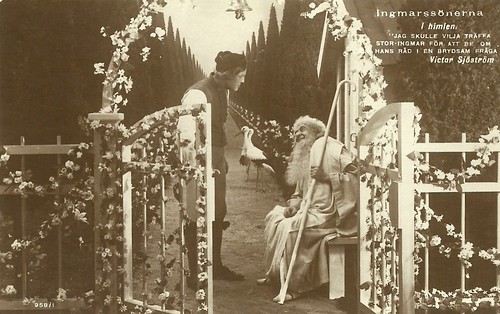
Swedish postcard by Nordisk Konst, Stockholm, no. 958/1. Photo: Svenska Biografteatern AB. Victor Sjöström in Ingmarssönerna/Sons of Ingmar (Victor Sjöström, 1919). Young Ingmar at Heaven's Gate. Caption: "I would like to meet Old Ingmar to ask for his advice in an awkward matter."
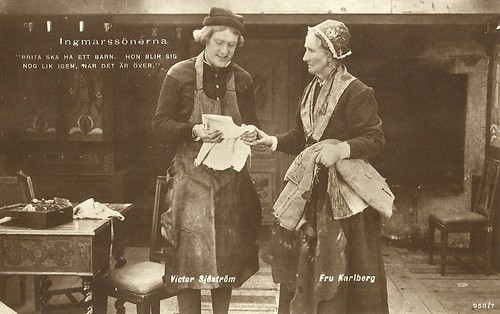
Swedish postcard by Nordisk Konst, Stockholm, no. 958/7. Victor Sjöström and Hildur Karlberg in Ingmarssönerna/Sons of Ingmar (Victor Sjöström, 1919). Caption: Mother: It is because Brita will have her child, but then she will recover and it will be over.
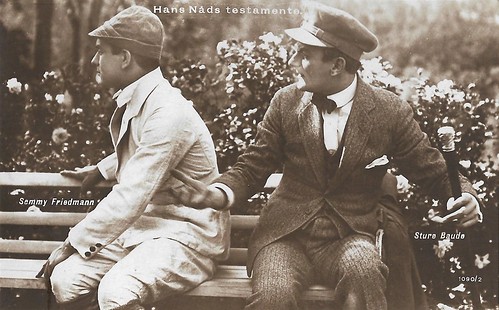
Swedish postcard by Nordisk Konst, Stockholm, no. 1090/2. Photo: Svenska Biografteatern. Semmy Friedmann and Sture Baude in Hans Nåds testamente/His Grace's Testament/His Lordship's Last Will (Victor Sjöström, 1919).

Swedish postcard. Nordisk Konst, Stockholm, no. 1092/14. Tora Teje in Klostret i Sendomir/Secret of the Monastery (Victor Sjöström 1920).
Adapting Selma Lagerlöf
The success of Terje Vigen/A Man There Was (Victor Sjöström, 1917) led to a change in Svenska Bio's production policy. Previously the company had been churning out about twenty films a year, but now the producers slowed down the rate of production and they gave each film a higher budget and more thought. That same year saw the release of the Selma Lagerlöf film adaptation Tösen från Stormyrtorpet/The Lass from the Stormy Croft (Victor Sjöström, 1917). Lagerlöf had been impressed by Terje Vigen and gave Sjöström the go-ahead to film this short story. The film was the first of Sjöström's five Lagerlöf films.
Victor Sjöström's next film was also a milestone in his career: Berg-Ejvind och hans hustru/The Outlaw and His Wife (1918), about the Icelandic outlaw Berg-Ejvind who falls in love with the wealthy widow Halla. The film was based on a play by the Danish-Icelandic writer Jóhann Sigurjónsson and, like Terje Vigen, was shot in real settings, this time in Abisko National Park in Lapland. The film was hailed almost unanimously as a great work of art. The depictions of nature were particularly praised. Sjöström starred opposite Edith Erastoff, who was expecting the couple's first child, and the couple's real-life infatuation is thought to add an extra lustre to the love story. In 1918, their daughter Gun ("Guje") was born. They married in 1922, after having to wait five years for her divorce.
Sjöström's other surviving silent Swedish films include Ingmarssönerna/Sons of Ingmar (Victor Sjöström, 1919), the sequel Karin Ingmarsdotter/Karin, Daughter of Ingmar (Victor Sjöström, 1920) and Körkarlen/The Phantom Carriage (Victor Sjöström, 1921), all based on stories by the Nobel-prize winning novelist Selma Lagerlöf. These films are marked by subtle character portrayal, fine storytelling and evocative settings in which the Swedish landscape often plays a key psychological role. The naturalistic quality of his films was enhanced by his, then-revolutionary, preference for on-location filming, especially in rural and village settings.
Ingmarssönerna/Sons of Ingmar (1919) and Karin Ingmarsdotter/Karin, Daughter of Ingmar (1920) are based on the first four chapters of 'Jerusalem', a novel by Lagerlöf, published in two parts in 1901 and 1902. The narrative spans several generations in the 19th century and focuses on several families in Dalarna, Sweden, and a community of Swedish emigrants in Jerusalem. It is loosely based on a real emigration that took place from the parish of Nås in 1896. Sjöström originally intended to film the entire novel but decided to cancel the project after the second film received an unenthusiastic critical response.
In 1919, Svenska Bio and Filmindustri AB Skandia merged to form Svensk Filmindustri (SF). The company's first project was Sjöström's Körkarlen/The Phantom Carriage (1921), which is considered Sjöström's greatest work and the pinnacle of Swedish silent film. Released on New Year's Day 1921, Körkarlen/The Phantom Carriage starred Victor Sjöström himself, alongside Hilda Borgström, Tore Svennberg and Astrid Holm. The characters and acting were of the highest order, and the trick filming and double exposures by Julius Jaenzon were groundbreaking. It is also notable for its advanced (for the time) narrative structure with flashbacks within flashbacks. The film was a huge success both nationally and internationally. When it premiered in New York, the film received a lyrical review in The New York Times and made Sjöström a household name. Later the film would be a major influence on Ingmar Bergman.

Swedish postcard by Nordisk Konst, Stockholm, no. 1093/7. Tora Teje in Karin Ingmarsdotter/Karin Daughter of Ingmar (Victor Sjöström, 1920).

Swedish postcard by Förlag Nordisk Konst, Stockholm, no. 1117/2. Photo: Svensk Filmindustri. Astrid Holm in Körkarlen/The Phantom Carriage, (Victor Sjöström, 1920).
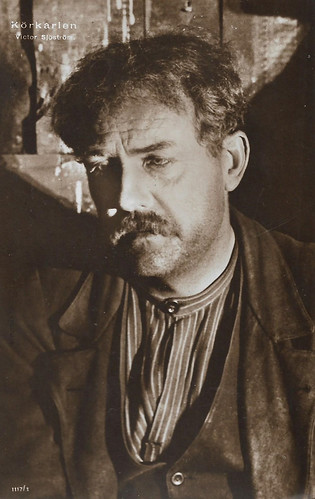
Swedish postcard by Förlag Nordisk Konst, Stockholm, no. 1117/3. Photo: Svensk Filmindustri. Victor Sjöström in Körkarlen/The Phantom Carriage, (Victor Sjöström, 1920).

Swedish postcard by Axel Eliassons Konstförlag, Stockholm, no. 300. Photo: Skandia Film. Gösta Ekman and Jenny Hasselqvist in Vem dömer/ Love's Crucible (Victor Sjöström, 1922).

Swedish postcard by Axel Eliassons Konstförlag, Stockholm, no. 304. Photo: Skandia Film. Gösta Ekman and Jenny Hasselqvist in Vem dömer/ Love's Crucible (Victor Sjöström, 1922).

Swedish postcard by Axel Eliassons Konstförlag, Stockholm, no. 329. Photo: Skandiafilm / Svensk Filminspelning. Meggie Albanesi in Det omringade huset/The Surrounded House (Victor Sjöström, 1922).
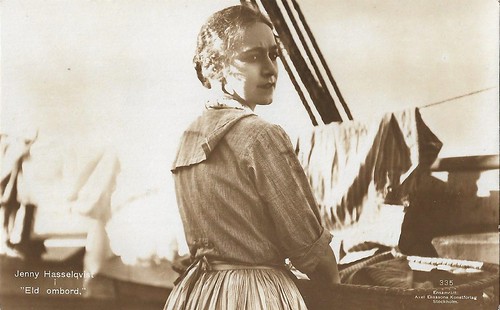
Swedish postcard by Axel Eliassons Konstförlag, Stockholm, no. 335. Photo: Svensk Filminspelning. Jenny Hasselqvist in Eld ombord/Fire on board/The Hell Ship (Victor Sjöström, 1923).

Swedish postcard by Ed. Axel Eliassons Konstförlag, Stockholm, no. 336. Photo: Svensk Filminspelning. Victor Sjöström and Jenny Hasselqvist in Eld ombord/Fire on board (Victor Sjöström, 1923).
The finest production we have yet seen
In 1922, Victor Sjöström received an offer to come and film in Hollywood. The following year, Sjöström and his family left for the United States. His family consisted of his wife Edith and their two daughters, Gun ('Guje") and Karin ("Caje"). They spent seven years in the country. In Sweden, he had acted in his own films as well as in those for others, but in Hollywood, he devoted himself solely to directing. During this time he directed a total of nine films for the newly formed Metro-Goldwyn-Mayer company, of which he became the biggest star director.
Credited as Victor Seastrom, he directed Name the Man! (1924) for Goldwyn Pictures. Goldwyn soon folded into Metro-Goldwyn-Mayer and Sjöstrom directed the psychological thriller He Who Gets Slapped (1924) starring Lon Chaney, Norma Shearer, and John Gilbert. The film was written by Sjöström and Carey Wilson and based on the Russian play 'He Who Gets Slapped' (Тот, кто получает пощёчины; Tot, kto polučájet poščóčiny) by playwright Leonid Andreyev. He Who Gets Slapped was the first film produced entirely by Metro-Goldwyn-Mayer and was highly profitable and critically hailed. In his 1924 review of the film for the New York Times, Mordaunt Hall praised the film's direction, performances, and story, calling it "the finest production we have yet seen". He Who Gets Slapped was important in the careers of Chaney, Shearer, Gilbert, and Sjöström.
He was highly respected by MGM chief Louis B. Mayer and by production head Irving Thalberg, who shared Sjöström's concerns with art that did not exclude profit. Among his other major Hollywood films are The Scarlet Letter (1926) and The Wind (1928), both starring Lillian Gish. In The Scarlet Letter (1926), Gish plays the adulterous Hester Prynne. Sjöström allows Hester a certain voluptuousness. When she leaves the bare rooms of the town for a date with her lover in the verdant woods, she defiantly pulls off her scarlet letter A, takes off her cap as well, and we see her beautiful, rich head of hair. The romantic drama The Wind (1928) featured also Lillian Gish, Lars Hanson and Montagu Love. It was one of the last silent films released by Metro-Goldwyn-Mayer and is considered to be among the greatest silent films.
Unlike the Swedish directors Mauritz Stiller and Hjalmar Bergman, who also tried their luck in the United States, Sjöström enjoyed both artistic and commercial success in that country. Sjöström became one of the most highly-paid directors in Hollywood, reaching his peak at the end of the silent era. Sjöström's first talkie was A Lady to Love (1930) starring Vilma Bánky and Edward G. Robinson. Robinson also appeared in the German-language version also produced and directed by Sjöström. Otherwise, with a different cast, it was released a year later in the United States as Die Sehnsucht Jeder Frau.
Uncomfortable with the modifications needed to direct sound films, Victor Sjöström returned to Sweden where he directed only two more films, the German language Väter und Söhne/Father and Son (1931) and the Swedish language version Markurells i Wadköping/Father and Son (1931). His final directing effort was for 20th Century Fox, the historical drama Under the Red Robe (1937). The adventure film, starring Conrad Veidt and Annabella and filmed in the United Kingdom, was set during the religious wars of early 17th century France.
Over the following fifteen years, Victor Sjöström returned to acting in the theatre, performed a variety of leading roles in more than a dozen films and was a company director of Svensk Film Industri. Aged 78, he gave his final acting performance, probably his best remembered, as the elderly professor Isak Borg who recalls his past in Ingmar Bergman's film Smultronstället/Wild Strawberries (1957) opposite Bergman regulars Bibi Andersson, Ingrid Thulin, and Gunnar Björnstrand. In 1960, Sjöström passed away in Stockholm at the age of 80.

German postcard by Ross Verlag, Berlin, no. 1587/1. Photo: Ufa. John Gilbert and Norma Shearer in He Who Gets Slapped (Victor Sjöström, 1924).

German postcard by Ross Verlag, no. 1885/1. Photo: Parufamet. Lillian Gish in The Scarlet Letter (Victor Sjöström, 1926).

Italian postcard by Ballerini & Fratini, Firenze, no. 403. Photo: Metro-Goldwyn-Mayer, Roma. Lars Hanson as Reverend Arthur Dimmesdale in the period piece The Scarlet Letter (Victor Sjostrom, 1926), set in the era of the Puritans.

French postcard by Europe, no. 330. Photo: Metro-Goldwyn-Mayer. Greta Garbo in The Divine Woman (Victor Sjöström, 1928).

German postcard by Ross Verlag, no. 3327/1, 1928-1929. Photo: MGM. This lady is not Greta Garbo, but Paulette Duval in costume for The Divine Woman (Victor Sjöström, 1928), in which she played with Garbo. Collection: Marlene Pilaete.

German postcard by Ross Verlag, no. 3822/1, 1928-1929. Photo: United Artists. Lillian Gish and Lars Hanson in The Wind (Victor Sjöström, 1928).

German postcard by Ross Verlag, no. 4509/1, 1929-1930. Photo: MGM. Eva von Berne and John Gilbert in The Masks of the Devil (Victor Sjöström, 1928).
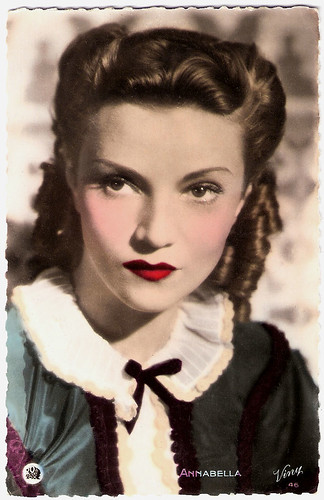
French postcard by Viny, no. 46. Photo: 20th Century Fox. Annabella in Under the Red Robe (Victor Seaström, a.k.a. Victor Sjöström, 1937).
Sources: Jon C. Hopwood (IMDb), Wikipedia (Swedish and English) and IMDb.
As you know the work of Victor Sjostrom is one of my passions, so thanks, you can only improve my writing.
ReplyDelete